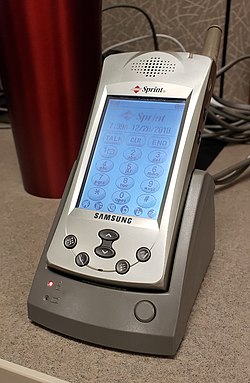This article needs additional citations for verification .(January 2021) |
 The i300 sitting on its charging cradle | |
| Manufacturer | Samsung Electronics |
|---|---|
| First released | Q4 2001 |
| Successor | Samsung SPH-i330 |
| Related | Handspring Treo 180 Kyocera 6035 |
| Compatible networks | Sprint CDMA 800/1900 / AMPS 800 |
| Form factor | candybar |
| Dimensions | 4.9 by 2.28 by 0.82 inches |
| Weight | 6 oz (170 g) |
| Operating system | Palm OS 3.5 |
| Memory | 8 MB [1] |
| Battery | Li-ion |
| Display | 160 × 240 px, 256 color |
| Connectivity | DE-9 Serial port via cradle, infrared (IrDA) |
| Data inputs | Graffiti, touchscreen |
The Samsung SPH-i300 is a smartphone running on Palm OS, manufactured by Samsung. [2] The device was released in October 2001 and marketed in the United States for use on Sprint's CDMA based cellular network. [3] [4] It was the first "PDA phone" (as devices that combined phone and PDA functions were then called) in the US with a color screen.
Contents
The phone has a candybar-style design. It operates like a standard color Palm OS device, but several hard (external) and software buttons launch the 'phone' application, which manages calls. The phone shipped with a charging cradle with a DE-9 serial port, extra battery, and a case.